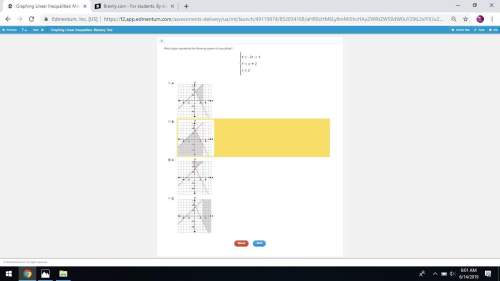
Mathematics, 02.02.2021 19:10 Jeli4264
Which graph best represents the function f(x) = (x + 2)(x − 2)(x − 3)? Graph of a cubic polynomial that falls to the left and rises to the right with x intercepts negative 2, 2, and 3. The graph intersects the y axis at a point between 10 and 15. Graph of a cubic polynomial that falls to the left and rises to the right with x intercepts negative 3, 2, and 3. The graph intersects the y axis at a point between 15 and 20. Graph of a cubic polynomial that falls to the left and rises to the right with x intercepts negative 3, 1, and 3. The graph intersects the y axis at a point between 5 and 10. Graph of a cubic polynomial that falls to the left and rises to the right with x intercepts negative 1, 1, and 4. The graph intersects the y axis at a point between 0 and 5.

Answers: 3


Another question on Mathematics

Mathematics, 21.06.2019 19:30
Cor d? ? me ? max recorded the heights of 500 male humans. he found that the heights were normally distributed around a mean of 177 centimeters. which statements about max’s data must be true? a) the median of max’s data is 250 b) more than half of the data points max recorded were 177 centimeters. c) a data point chosen at random is as likely to be above the mean as it is to be below the mean. d) every height within three standard deviations of the mean is equally likely to be chosen if a data point is selected at random.
Answers: 1

Mathematics, 21.06.2019 22:00
For [tex]f(x) = 4x + 1[/tex] and (x) = [tex]g(x)= x^{2} -5,[/tex] find [tex](\frac{g}{f}) (x)[/tex]a. [tex]\frac{x^{2} - 5 }{4x +1 },x[/tex] ≠ [tex]-\frac{1}{4}[/tex]b. x[tex]\frac{4 x +1 }{x^{2} - 5}, x[/tex] ≠ ± [tex]\sqrt[]{5}[/tex]c. [tex]\frac{4x +1}{x^{2} -5}[/tex]d.[tex]\frac{x^{2} -5 }{4x + 1}[/tex]
Answers: 2

Mathematics, 21.06.2019 22:00
Which of the following graphs could represent a cubic function?
Answers: 1

Mathematics, 21.06.2019 23:40
Statement reason 1. δabc is similar to δced. given 2. 3. definition of slope 4. slope of slope of definition of slope 5. slope of × slope of multiplying the slopes 6. slope of × slope of substitution property of equality 7. slope of × slope of simplifying the right side the table contains the proof of the relationship between the slopes of two perpendicular lines. what is the reason for statement 2? a. parallel line segments that meet a common perpendicular line are proportional in length. b. the lengths of vertical and horizontal sides in congruent triangles are in a common ratio. c. trigonometric identities determine the lengths of the legs in a right triangle. d. corresponding side lengths in similar triangles are proportional in length.
Answers: 2
You know the right answer?
Which graph best represents the function f(x) = (x + 2)(x − 2)(x − 3)? Graph of a cubic polynomial t...
Questions

History, 03.07.2019 06:00

History, 03.07.2019 06:00

Mathematics, 03.07.2019 06:00

Mathematics, 03.07.2019 06:00

Mathematics, 03.07.2019 06:00


Mathematics, 03.07.2019 06:00



History, 03.07.2019 06:00

Biology, 03.07.2019 06:00


Social Studies, 03.07.2019 06:00


English, 03.07.2019 06:00

English, 03.07.2019 06:00



Mathematics, 03.07.2019 06:00




